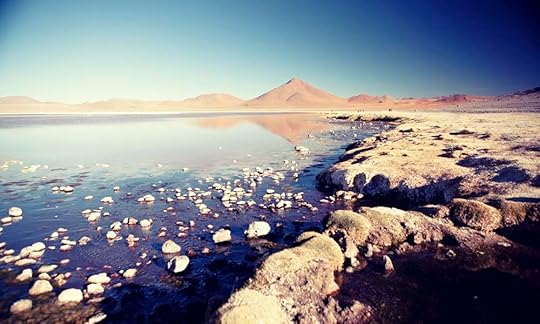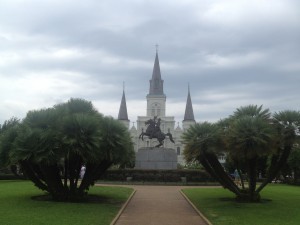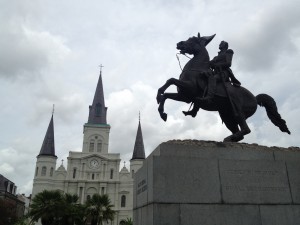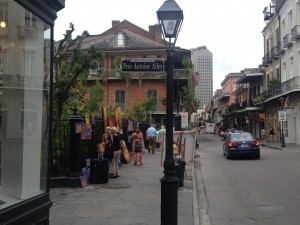Rolf Potts's Blog, page 82
August 29, 2012
Vagabonding Case Study: Jerry Walsh
Vagablogging :: Rolf Potts Vagabonding Blog
Jerry Walsh
https://www.facebook.com/profile.php?id=1564560239
Age: 21
Hometown: Charlottesville, VA
Quote: “At the end of the day, I evolved from being an outsider looking in to becoming a functioning member of the community. Integration is what vagabonding is about.”
How did you find out about Vagabonding, and how did you find it useful before and during the trip?
A fellow traveller I met in Bodh Gaya, India recommended it to me. I actually read the book after I got back from my trip and it confirmed that long term travel as a lifestyle is not some far fetched fantasy that one needs to grow out of. Quite the opposite.
How long were you on the road? 11.5 months
Where all did you go? India, Nepal, and Bhutan
What was your job or source of travel funding for this journey? Savings from the years
Did you work or volunteer on the road?
I was a volunteer in Kathmandu, Nepal for three months working at a Nepali run outdoor leadership school called Initiative Outdoor where I worked with local Nepali kids teaching them outdoor skills and environmental awareness. I was also a student for 6 months.
Of all the places you visited, which was your favorite?
Ladakh, India is one of the most breathtaking places I have ever seen. Every moment there was surreal and awe-inspiring. I rented a motorcycle and cruised for several days through the Tibetan plateau just loving life. I also violently crashed that motorcycle but in a way that made it all the better. I also loved Taktsang monastery in Bhutan–another mesmerizing place. Varanasi, Bodh Gaya, Laksahdweep Islands…Every place was a doorway into a sacred dimension.
Was there a place that was your least favorite, or most disappointing, or most challenging?
Bhutan was challenging at times due to the government restrictions. I was not allowed to venture off on my own and it felt confining. However, the land and the people are both beautiful and balanced the trip out. Sketch ball opium dealers hounding me in the constipated smog of Varanasi could be a little overwhelming but I took it as a test of patience.
Did any of your pre-trip worries or concerns come true? Did you run into any problems or obstacles that you hadn’t anticipated?
Surprisingly I’m not dead and I still have all my organs and limbs in tact. I only partially shattered my eyebrow crashing a mountain bike while intoxicated from Tibetan chang in Kathmandu. I woke up from unconsciousness bleeding profusely from the head and staggering in the middle of the street at midnight somewhere around Lalitpur…My eyebrow still doesn’t grow hair fully but it makes for a good story. The biggest and most unpredictable problem that I came across was falling in love with a girl–made Delhi belly seem appetizing when we parted ways.
Which travel gear proved most useful? Least useful?
Most useful: Backpack obviously and my bandana was clutch. A camera is always a must.
Least useful: Water purifying tablets and a bunch of other worthless medical supplies I could have purchased abroad for a fraction the price–used basically none of it–a lesson learned: PACK TIGHT YOU NEED LESS THAN YOU THINK!
What are the rewards of the vagabonding lifestyle?
FREEDOM, ability to explore both your inner and outer realities, knowing yourself, following your inner guidance, intuition, dreams, and bliss. You even lose track of what day it is…Is it Monday? Or Thursday? Need I say more? Exactly.
What are the challenges and sacrifices of the vagabonding lifestyle?
You are stuck in a perpetual cycle of short term relationships unless you brought a compadre for the long haul. This can be annoying because introducing yourself for the seven thousandth time looses its luster rather quickly…The best way I can sum up the challenges you experience is letting go. You aren’t holding onto much materially and your identity looses its reinforcements constantly so you learn to carry yourself.
What lessons did you learn on the road?
Learning to let go is probably the hardest but most rewarding lesson you will ever learn and traveling is a damn good teacher. When you see how the flow of traffic operates on the roads of India you realize that your fate is in the hands of the gods–or at least the bus driver and his sobriety and sanity are in question…. I also learned to transmute loneliness into self-love. That was a hard lesson at first but once you get the hang of it you really learn to enjoy your own company. The other difficulty is seeing the suffering of others. We are all interconnected in more ways than we realize and seeing the illness, poverty, and pollution of developing countries really makes you question your lifestyle choices and how they affect others.
How did your personal definition of “vagabonding” develop over the course of the trip?
I played several roles abroad. I was a student, a researcher (did a 40 page research paper on Buddhist pilgrimage ), a free floating aimless wander without a clue–just following the vibes, then a student again (studying Tibetan and Himalayan culture), then a researcher once more (another paper on Ladakhi shamanism), and then finally a volunteer living with a Nepali family…At the end of the day, I evolved from being an outsider looking in to becoming a functioning member of the community. Integration is what vagabonding is about to me. Go anywhere, do anything, be anyone, and let everything unfold as it should.
If there was one thing you could have told yourself before the trip, what would it be? Surrender and go with the flow
Any advice or tips for someone hoping to embark on a similar adventure?
Follow your heart and trust everything will work out in the end. There is something very special inside of you that wants to be expressed and when you travel it is revealed to you…
When and where do you think you’ll take your next long-term journey?
I’m planning on going to Peru to finish a spanish requirement for my undergrad this summer for a few months hopefully. I’m planning on getting involved with an ayahuasca retreat center and furthering my research on shamanism/traditional medicine. I’m then headed to Burning Man and from there…go with the flow…
Website: https://www.facebook.com/profile.php?id=1564560239
Are you a Vagabonding reader planning, in the middle of, or returning from a journey? Would you like your travel blog or website to be featured on Vagabonding Case Studies? If so, drop us a line at casestudies@vagabonding.net and tell us a little about yourself.
Original article can be found here: Vagabonding Case Study: Jerry Walsh
August 27, 2012
3 Attitudes you need to make your dream come true
Vagablogging :: Rolf Potts Vagabonding Blog
 I’m sure you’ve heard the excuses. I know I’ve heard more of ‘em than I ever thought existed.
I’m sure you’ve heard the excuses. I know I’ve heard more of ‘em than I ever thought existed.
I don’t have time
I don’t have money
I have responsibilities
I would love to, but…
In the end there are a million reasons not to live your dream, but all you really need are a small handful of reasons to do it. It all comes down to priorities.
If you are happy with your life at the moment, then there’s nothing you need to change. If, however, there is something you’re not happy with, it’s up to you to change it.
You have a choice. You can continue doing what you’ve been doing and you’ll get the same things you’ve been getting. If you want something different, you need to do something different. You know the saying: Insanity is doing the same thing over and over but expecting a different outcome. It’s true.
Set your priorities in life and then take steps to get there. It won’t be easy. It won’t come without work. Your dream won’t fall in your lap. YOU make that dream happen.
When we decided to ride our bikes from one end of the world to the other, we worked toward it with an undying sense of commitment and passion. Every action and thought was focused on making that dream come true. We woke up in the morning and thought about what steps we would take that day and in the evening we looked back on the progress we made. Baby steps to be sure, but they were steps in the right direction.
As I look back on that time period now, I realize there were three key attitudes and beliefs that were in place in order for us to be successful.
1) Believe in your dream and in your ability to do it
We knew we could do it. We knew it was possible for us to pedal from one end of the world to the other. We knew it wouldn’t be easy and we knew it would be a whole bunch of little bike rides, but we knew we could do it. If you don’t truly believe you can do it, you won’t even try.
2) Know that you want to do it
I think this is the biggest stumbling block around. Is your dream an all-consuming passion? Is it something you are willing to truly give your all to? If not, I’ll guarantee something else will come along that will distract you.
3) Be willing to sacrifice for it
Is your dream something that you’d kinda, sorta like to do but not something you’re willing to pay the price for? Whenever I walk around the store I see a whole lot of things I’d kinda, sorta like to have, but decide they aren’t worth the price. Dreams are like that too – they’ll cost, but are oh-so-worth-it when you’ve got the exact dream you want. Are you willing to dedicate years of your life to your dream?
The clock is ticking. You can never go back. Take advantage of every moment now – before it’s too late.
Feeling like you know you want to design your own life, but can’t quite make it over the hurdles to get there? A friend and I will starting up a new session of our 3-month bootcamp in the art of dreaming big dreams and making them happen. We would love to have you join us! Read more here: www.dreamreboot.com
Original article can be found here: 3 Attitudes you need to make your dream come true
Meet a 19-year-old travel hacker
Vagablogging :: Rolf Potts Vagabonding Blog
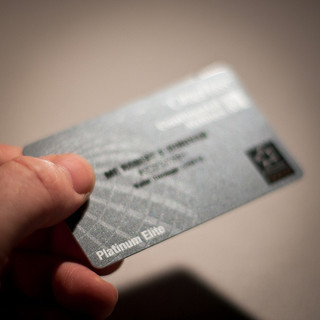
Platinum Elite credit card. Photo: Robert S. Donovan / Flickr
When we think of a “travel hacker,” the instant image that springs to mind is Ryan Bingham, the corporate road warrior memorably portrayed by George Clooney in the film “Up in the Air.” Can young people get in on the frequent-flyer game?
Yes, says Hao Tran, a college student featured in the Million Mile Secrets blog. In his interview titled, Never Stays at Hotels, he describes some of the amazing experiences that free flights have opened up for him. They include attending the 2012 London Olympics and going up the Burj Khalifa (the world’s tallest building) shortly after watching Mission Impossible 4.
His best tip for getting more miles was to complain to the airline if you have a legitimate grievance about a bad flight. One e-mail snagged him 20,000 miles. Tran stressed that it must be an honest complaint and this technique shouldn’t be abused.
As for the headline, “Never Stays at Hotels,” Tran explained that he prefers to stay in youth hostels. Although he’s also expanded to using Airbnb as well to stay in private residences.
Original article can be found here: Meet a 19-year-old travel hacker
August 26, 2012
On the road, vulnerability can be a way of keeping safe
Vagablogging :: Rolf Potts Vagabonding Blog
“There was another message, too: Once again, the more I gave myself to the world, the more I made myself vulnerable by putting myself completely at the disposal of people and situations in which I had no control, the more people took care of me, looked out for me. At first I had thought they were taking pity on me. But as my journey unfolded, I started to understand something else, something that had been sinking in gradually over the months. Being a white American conferred on me an automatic status. I represented power. Affluence. …And if I could shed my American reserves, phobias, disgusts, they would embrace me. In the weeks ahead I would do whatever my fellow travelers and hosts did. If they drank the tap water of Mumbai and Kolkata and Bangladesh, so would I. If they bought tea from street corner vendors, so would I. If they ate with their fingers, even if I was given utensils, I ate with my fingers. Doing so prompted an outpouring of generosity and curiosity that never ceased to amaze me; it opened the door, made people take me in. That I shared their food, their discomfort, their danger, fascinated and validated them in a powerful way.”
–Carl Hoffman, The Lunatic Express (2010)
(2010)
Original article can be found here: On the road, vulnerability can be a way of keeping safe
August 25, 2012
Vagablogging Field Report: into the wild in Bolivia’s salt flats
Vagablogging :: Rolf Potts Vagabonding Blog
Cost/day:
The three-day trip cost £100 including meals and accommodation.
What ’ s the strangest thing you ’ ve seen lately?
Bolivia’s Salar de Uyuni. The salt flats are over 10,500 square kilometers and stretch as far as the horizon. It’s a dazzling, brilliant white landscape, made more spectacular by being the remains of an ancient lake. The otherworldly Salar is surrounding by mountains and dotted with islands filled with cacti. You can’t help but think ‘wow‘.
Describe a typical day:
Although typically called a salt flats tour, the first two days are spent travelling through the desert. We started in Chile’s San Pedro de Atacama and visited striped volcanoes, multi-coloured lakes, steaming geysers and thermal waters. There is no typical day in this landscape.
What do you like about where you are? Dislike?
 I enjoyed every moment of the landscape of this three-day trip – there was always a new surprise awaiting at every corner. My highlights were a red lagoon edged by brilliant yellow sulphur, the salt flats themselves, and taking a dip in thermal waters in the middle of the desert.
I enjoyed every moment of the landscape of this three-day trip – there was always a new surprise awaiting at every corner. My highlights were a red lagoon edged by brilliant yellow sulphur, the salt flats themselves, and taking a dip in thermal waters in the middle of the desert.
The nights were very cold, but I had been warned of this beforehand so wrapped up warm in Andean wools. The altitude made if difficult to breathe the first night and, coupled with the cold, made for an uneasy night’s sleep. But the scenery soon perked everyone up the following morning and the difficulties were forgotten.
Describe a challenge you faced:
Choosing a salt flats tour was tricky, The wild terrain means a guide is a necessity and there are plenty of horror stories about kamikaze, drunk drivers and crashes. We went with Cordilliera Traveller who have a great safety record. While our driver was rather unfriendly, he was at least safe. I, luckily, didn’t suffer too much from the altitude but others in the group did, especially on the first night when a few were crippled by headaches. These cleared up on the second day.
What new lesson did you learn?
 Flamingos are pink because of the type of shellfish and algae they eat. We saw hundreds on our journey around the desert and a few were almost white. Also, who would have thought that such delicate, pretty looking creatures were so hardy? This is the second time we’ve seen them on this trip and the last time was in Patagonia – both such cold, unforgiving climates. I’ve spent most of my life thinking they were tropical birds.
Flamingos are pink because of the type of shellfish and algae they eat. We saw hundreds on our journey around the desert and a few were almost white. Also, who would have thought that such delicate, pretty looking creatures were so hardy? This is the second time we’ve seen them on this trip and the last time was in Patagonia – both such cold, unforgiving climates. I’ve spent most of my life thinking they were tropical birds.
Where next?
We are travelling in Bolivia for a few weeks before heading into Peru. I’m then off to Europe for a few weeks for two travel blogging conferences. After that, I’ll go and join Steve again in Ecuador. Read more about our adventures on Bridges and Balloons.
Original article can be found here: Vagablogging Field Report: into the wild in Bolivia’s salt flats
August 24, 2012
Vagabonding Field Report: Scorpion with a side of Cajun sauce in New Orleans
Vagablogging :: Rolf Potts Vagabonding Blog
Cost/day: $150/day
What’s the strangest thing you’ve seen lately?
It is a toss-up between me eating a scorpion and some of the “characters” I saw on Bourbon Street.
Describe a typical day:
Start the morning off in the French Quarter at Café du Monde to try their famous beignets and coffee. Walk over to the St. Louis Cathedral – the oldest Catholic cathedral in the United States. Take a stroll through the French Market. Check out the Voo Doo Museum. Get some Cajun shrimp and grits for lunch. Drive through the inner city to see the destruction still visible from Hurricane Katrina. Go to the oldest bar in the United States, Jean Lafittes Blacksmith Shop, which dates back to 1772. Go to the Napoleon House, a bar that was intended to be the residence for Napoleon Bonaparte in a local plan to bring Napoleon to Louisiana after his exile. Get a dinner of fried oysters, gumbo and lobster. Go to Lucy’s and eat a scorpion. Party on Bourbon Street.



Describe an interesting conversation you had with a local:
I was talking to an older guy and he exemplified the passion that many people in New Orleans have for their city. It never came across as arrogant, just confident happiness in the fact that they feel that they have the best culture, food, music, history, football team and nightlife in the country.
What do you like about where you are? Dislike?
I liked how the culture in New Oreleans is perhaps more dynamic than any other city in the United States. Its Creole and Greek revival architecture, iconic jazz and blues musicians, spicy Cajun food, diverse demographics, legendary nightlife, rich history and strong French influence makes it a fascinating place to visit.
One could easily miss this if only visiting the French Quarter and other popular neighborhoods, but it was a somber experience to see the parts of the city that were destroyed and have still not been fixed or rebuilt since 2005 due to Hurricane Katrina. These areas were generally the lower income sections of the city and certain parts looked like a ghost town with overgrown weeds the size of houses.
Describe a challenge you faced:
Only minutes after my arrival, a flash flood warning came into effect and the torrential downpour began. I was only there for a few days, so I didn’t want to have it ruin my trip. Determined not to let that thwart our plans, my friends and I decided to embrace the rain. We ran through the city, ate some great food and went out on Bourbon Street all while completely soaking wet and leaving a trail of water everywhere we went. This made for some great times, especially when one of our friends completely wiped out in a restaurant from slipping on his own puddle of water.
What new lesson did you learn?
I was amazed how many of the locals had no desire to live anywhere else. Having lived in some very transient and international U.S. cities (San Francisco, Chicago, Washington DC) and having traveled a lot, this was such a foreign concept to me. However, I realized how some people just perfectly fit with some cities. It is as if they found their destination soul mate. It doesn’t mean it is perfect, but like a good mate, it is perfect for them. At the exact moment that I was thinking about this, I coincidently read the following quote by Ian McNulty: “People don’t live in New Orleans because it is easy. They live here because they are incapable of living anywhere else in the just same way.” Does everyone have a destination soul mate or do most people simply settle where life sent them (or never stop searching for those that are vagabonding)?
Where next?
I will be travelling back and forth between Washington DC, Chicago, New York, North Carolina and Tennessee for a few months and then I plan on travelling throughout East and Southeast Asia.
Original article can be found here: Vagabonding Field Report: Scorpion with a side of Cajun sauce in New Orleans
August 23, 2012
Realities of Travel Writing, part 2: Getting the Assignment
Vagablogging :: Rolf Potts Vagabonding Blog
In this second installment of Realities of Travel Writing, I’m continuing on the topic of getting the assignment. It bears fleshing out, as you can’t board the plane until you land the gig. So, first thing’s first.
After you’ve come up with a great article idea and researched the websites, blogs, or magazines you want to pitch it to, there’s still a lot more to be done.
Firsts, is your idea in line with what they specialize in? What is their market or target audience, and how is your article idea relevant to them? Some blogs/websites/magazines are quite open to all facets of travel, but some are “niche,” i.e. quite focused on one part of the world or aspect of the experience of traveling. The editor is the audience, for the purposes of pitching. Know their needs well or you’ll be wasting your time and theirs.
Similarly, know the tone and style of the publication you’re approaching. Tailor your pitch accordingly. For example, World War II Magazine will have a more professional, academic tone than, say, a free-wheeling blog dedicated to twenty-somethings with wanderlust. Again, know your audience. If you pitch them without knowing anything about their market it will show and they will shut you down fast.
Also, more research to be done: Have they published a piece similar to your idea recently? If so, they won’t be interested in repetition. Be aware of what they haven’t covered lately and leverage that in your pitch. Editors of magazines, websites, and blogs are always scrambling for fresh ideas. They need new content constantly, and are aware of the perils of repetition and stagnation.
The bottom line: Come to their rescue with an original, well fleshed-out piece that is in line with their purpose, market, tone and style, and you’ll be surprised how receptive they can be.
Original article can be found here: Realities of Travel Writing, part 2: Getting the Assignment
A wiki for hitch hikers
Vagablogging :: Rolf Potts Vagabonding Blog
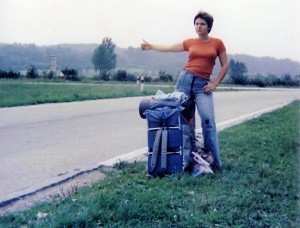 As I am thumbing my way across the Central Asian republics, I made a very much welcome discovery by typing “hitching to Dushanbe” in Google. What I found was a bit puzzling, at first: I would have never thought that a volatile, hazardous and utterly non-scientific art such as hitching a ride could have a wiki website!! But it really has!
As I am thumbing my way across the Central Asian republics, I made a very much welcome discovery by typing “hitching to Dushanbe” in Google. What I found was a bit puzzling, at first: I would have never thought that a volatile, hazardous and utterly non-scientific art such as hitching a ride could have a wiki website!! But it really has!
Hitchwiki is some sort of Wikipedia of hitching, and it works wonders. Subdivided into geographic areas and countries, it gives you proper practical information from the mouths of experienced hitch hikers. You may now tackle every country’s highway with the right dose of preparation. And if you believe you do not need it, it means you have never thumbed a ride before!!
As the simplest example: how to get out of a city to actually be able to stop the car and get the ride you want? Do you think you may start hitching in the city center of Paris? This website proves extremely useful as it gives a low down on the ways to reach the toll heads of the most useful highways, and describes accurately what kind of city transport you may take to get there. I got some very useful information on how to leave the city center of Khujand and arrive directly in front of the Dushanbe highway using public transport. As Hitchwiki suggested, I got there, and in five minutes I was riding happily – and free of charge – down the highway towards my destination.
For some countries this sites suggests useful hitching language and a detailed description of some cultural aspects you may come across – or against – during your hitching adventures are readily explained. Such as the concept of Tarof in Iranian society: according to this, a driver would never ask you to pay for a ride, although he may want to, as many private cars in Iran are unlicensed taxis!!
I am glad I made such a discovery and that hitch hikers decided to share their experience and knowledge for the joy of other road adventurers… and I am also psyched to have more reasons to leave the bus stations’ touts and hassle behind!!
Original article can be found here: A wiki for hitch hikers
August 22, 2012
Do you have a fear of flying?
Vagablogging :: Rolf Potts Vagabonding Blog
An eleven-year-old British boy and his father will soon embark on a 3,500 mile overland journey from the UAE to the UK along the safest route possible. The family is relocating back to London. Their son, Joe, experienced paralyzing anxiety about flying for the first time. Several failed attempts to re-board the plane have been made. For the last six weeks therapy, hypnosis, and a sedative injection were tried, but none have worked. Oddly, the boy has flown many pervious times without problems.
Do you have a fear of flying?
You’re not alone. According to many studies about 40 percent of people have anxiety associated with airline travel–even those who fly on a regular basis. Fear like being out of control, of crashing, claustrophobia, and with heightened security of TSA. Several of my friends refuse to fly because of one or more of those reasons. John has only flown once in his life and barely left the State he grew up in. Sparing emotional details he just says, “I don’t like it.” At one time he worked at an airport refueling planes—not sure if that helped or hindered the situation. But as fate would have it, John shall take the second flight of his life in two weeks. He called me when he booked tickets, and said he’d call me again to make sure he’s up-to-date on packing requirements for TSA. I’m sure I’ll hear from him while he’s waiting at the gate. Flying aside, he suffers from sensory overload problems which lead to panic attacks on a normal basis. As I’ve discovered, which I bet many of you have too, traveling opens great horizons. For many years John has said, “We gotta go to Ireland for your 30th birthday.” Now that is less than a year away. I hope his next flight is a pleasant experience.
I can relate to both Joe and John’s anxiety. Mine however was separation-anxiety linked to airline travel. When I was eight, my parents got divorced and as a result lived in different states. Twice a year I’d be put on the plane by one…and collected at the other end by another. At least, back in those days, passengers without tickets could accompany friends and family right up to the boarding gate. My, my have times changed…
That anxiety lasted well into my late teens before I gained control of it. However a different type cropped up last year when my Service Dog, Trinity and I prepared for our first flight together. Rather than starting small, we went straight to the big-leagues and flew internationally. And for an added challenge, I chose to depart from THE international airport linked to my childhood anxieties–Logan in Boston, Massachusetts. That turned out to be an extremely positive move, because every security personal we encountered was accustom to seeing Service Dogs! Within three months we took a total of eight flights spanning eleven times zones. Turns out my pre-flight anxiety was much worse. The airlines “misplaced” our bag in Paris for over an hour. Then the chaos got worse. We boarded the train where workers decided to strike, tripling the crowds of frustrated travelers on the first day of spring. What remains vivid about that first flight was the Steward who brought extra chicken treats for Trinity. The lost luggage attendant insisted on bringing her multiple cups of spring water while we waited. Everyone on the overcrowded train pushed and shoved each other but was extremely aware not to step on her tail. Unlike most people, my dogs’ favorite part of flying is the TSA pat down! It’s one of the few times she gets attention from someone other than me while in uniform.
Special note: If you happen to be a Service Dog Handler and are considering flying with your dog; please feel free to contact me and I’d be happy to chat further about my experiences to share more information.
Here are a few ideas to help battle flight anxiety:
1) For those of you technologically minded, “There’s an app for that!”
2) Virgin Atlantic has a course to take complete with flight simulator. So does iPilot.
3) Captain Stacey Chance has put together a free online self-help course that also has an audio download so you can take it with you and listen on the flight!
But electronics aside, anxiety can also be relieved with pressure points. Ever wonder why the human reaction is to hug someone when they are upset? Without realizing, the exchange of a firm hug triggers good endorphins because of a point around ones collar bone. But obviously you can’t have someone hugging you the whole flight; so try these other points on your hands.
1) Pinching the “meat” of your hand between thumb and index finger
2) Pressing the indention of your wrist at the base of thumb
3) Pressing either side of your index finger at the tip and below the knuckle
For visual guidance check out this video.
In addition “The Emotional Freedom Technique” involves tapping points on the hands, head, face and collar bone, combined with words. Here’s an introduction video.
Pressure point triggering is a task taught to Service Dogs for people with sensory issues. This is one of the tasks my dog does.
If you notice someone else who has a fear of flying, refrain from running up to hug them. A stranger might not be receptive to your thoughtful gesture. However, try to politely share about the pressure points on their hands.
Happy flying, everyone!
Original article can be found here: Do you have a fear of flying?
August 20, 2012
Overplanning is the death of many a dream
Vagablogging :: Rolf Potts Vagabonding Blog
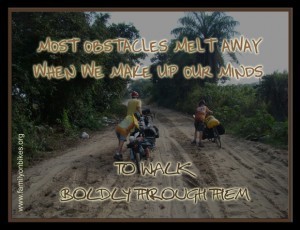 You’ve been there. I’ve been there. I think we’ve all had some kind of dream and spent many weeks and months planning, preparing, and dreaming. And then we get overwhelmed by it all and scared by all the what-ifs and we decide we don’t want to do it after all.
You’ve been there. I’ve been there. I think we’ve all had some kind of dream and spent many weeks and months planning, preparing, and dreaming. And then we get overwhelmed by it all and scared by all the what-ifs and we decide we don’t want to do it after all.
Overplanning is the death of many a dream.
Planning is important – I’ll never say otherwise. It’s important that we know what we need to know and have what we need to have. But, as college kids learn quickly, there are other things that are best left unsaid.
You want head out vagabonding around the world? Grab a backpack and go. Don’t overplan. Don’t freak out at all the things that could go wrong but probably won’t. If you focus on the what-ifs, you’ll never make it anywhere.
As we cycled from Alaska to Argentina with our children, there were plenty of things that could have happened. We could have gotten hit by a car, but we didn’t. We could have gotten lost, but we didn’t. Our entire journey was filled with could haves, but the vast majority of them didn’t happen. If they had, we would have dealt with them then.
Know in the back of your mind that something can happen. It’s possible that things will go terribly wrong. Not likely, but possible. Know also that there is no way to plan or prepare for that thing, so leave it way back there in the deepest recesses of your brain and go anyway.
Don’t overplan or you’ll never hit the road.
Original article can be found here: Overplanning is the death of many a dream
Rolf Potts's Blog
- Rolf Potts's profile
- 323 followers



